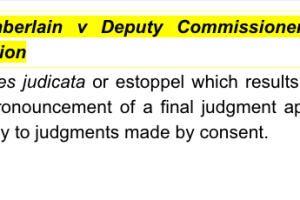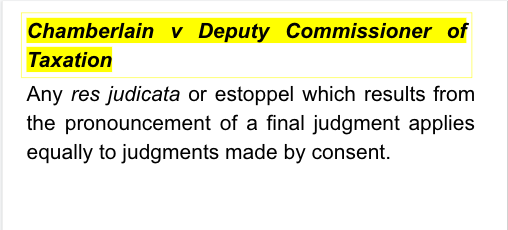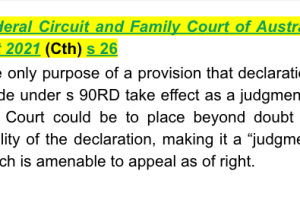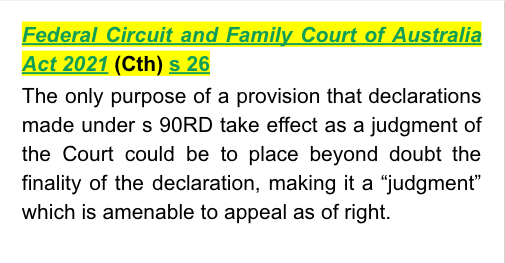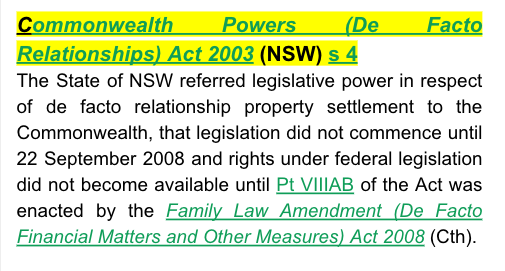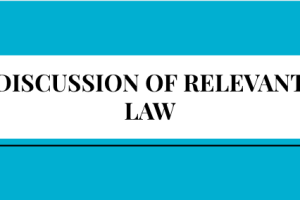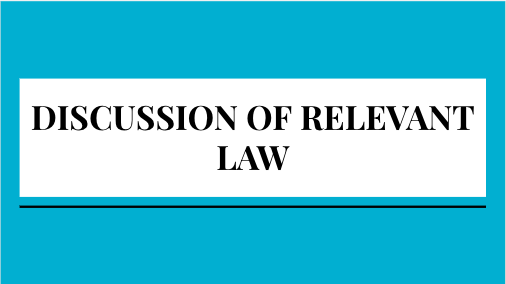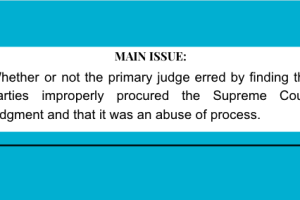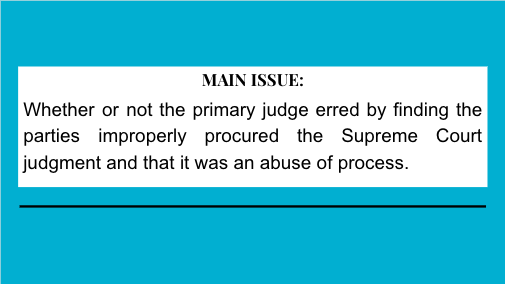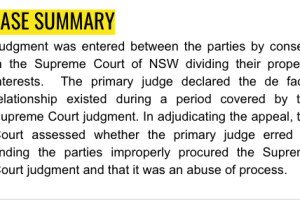- · 4780 friends
Parties Dispute De Facto Relationship

Colburn & Cleese [2022] FedCFamC1A 147 (23 September 2022)

Judgment was entered between the parties by consent in the Supreme Court of NSW dividing their property interests. The primary judge declared the de facto relationship existed during a period covered by the Supreme Court judgment. In adjudicating the appeal, the Court assessed whether the primary judge erred by finding the parties improperly procured the Supreme Court judgment and that it was an abuse of process.

Facts
The husband admits the parties were in a de facto relationship from 1995 until the end of 2000, but contends their legal rights arising from that relationship merged in the Supreme Court judgment in 2006. The wife, however, contends for a relationship of much greater length, beginning in 1990, subsisting when the Supreme Court judgment was entered in 2006, and not finally ending until May 2014. The dispute over the length of the de facto relationship and the timing of its breakdown was fundamental to the establishment of jurisdiction to entertain the wife’s application for property settlement under Pt VIIIAB of the Act, filed in April 2016, as one pre-condition to the existence of federal jurisdiction is that the de facto relationship did not end until after 1 March 2009. The primary judge duly found it did.
The primary judge found the relationship did not begin quite as early as the wife alleged, but that it endured until May 2014, though punctuated by several periods of separation. The specific findings, as reflected in the declaration made, were that the de facto relationship existed during these periods: (a) 1991 to 1994; (b) 1995 to the end of 2000; (c) September 2006 to July 2010; (d) January 2011 to October 2012; and (e) April 2013 to May 2014. Such findings collided with the Supreme Court judgment, entered in November 2006 on the premise that the parties’ de facto relationship had broken down four years prior in November 2002, thereby enabling the consequential adjustment of their property interests under the State Act. Yet the primary judge contrarily found the parties’ de facto relationship broke down earlier than 2002 and was back in full swing before November 2006.
Realising that the Supreme Court judgment obstructed the grant of any subsequent property settlement relief under Pt VIIIAB of the Act covering the whole of the de facto relationship, which was declared to reach as far back as 1991, the primary judge accepted the wife’s submission that his Honour was vested with power under the State Act to set aside the Supreme Court judgment and smooth the way for a fresh exercise of discretionary power. In purported exercise of power under the State Act, the primary judge determined to set aside the Supreme Court judgment (at [131]–[161]) and found there was no need to then consider the wife’s alternate argument about the husband being precluded by principles of estoppel from reliance upon the Supreme Court judgment. The primary judge did not conversely deal with the husband’s proposition that principles of estoppel precluded the wife and his Honour from going behind the Supreme Court judgment, which oversight is fatal to the validity of the judgment.

Issue
Whether or not the primary judge erred by finding the parties improperly procured the Supreme Court judgment and that it was an abuse of process.

Applicable law
Commonwealth Powers (De Facto Relationships) Act 2003 (NSW) s 4 - wherein the State of NSW referred legislative power in respect of de facto relationship property settlement to the Commonwealth, that legislation did not commence until 22 September 2008 and rights under federal legislation did not become available until Pt VIIIAB of the Act was enacted by the Family Law Amendment (De Facto Financial Matters and Other Measures) Act 2008 (Cth).



Analysis
The husband did not file any Defence to refute the wife’s pleadings, so the pleaded facts were deemed admitted under the State Rules. The litigation was eventually settled and judgment was entered on 28 November 2006, with orders made for the parties to divide their real and personal property on an agreed basis. There was no evidence that the wife amended her pleadings at any time during the pendency of the Supreme Court proceedings so, when the compromise was consummated in November 2006 by the Supreme Court exercising its statutory power under the State Act to order the adjustment of the parties’ property interests, it was upon the premise of the jurisdictional facts within the verified and admitted pleadings. The right to property settlement relief had already been asserted and determined by the Supreme Court judgment.
The wife was estopped from contending the de facto relationship was still in existence at a time when the Supreme Court judgment was premised upon its cessation. The finding made by the primary judge about the existence of the de facto relationship before the entry of the Supreme Court judgment hinged entirely upon acceptance of the wife’s uncorroborated evidence, but in circumstances where: first, her evidence on the issue was found to be “sparse”; secondly, her evidence was refuted by the husband; thirdly, both parties’ credit was found wanting (at [10]); and lastly, her evidence was in direct conflict with her former verified representations of fact to the Supreme Court.
Resort to the use of power under the State Act to set aside the Supreme Court judgment in the exercise of accrued jurisdiction was not intrinsic to the disposition of the wife’s federal claim. It was not reasonably open for the primary judge to find the parties intentionally misled the Supreme Court and abused its process by procuring its judgment without there being a sound jurisdictional basis.
Conclusion
The appeal is allowed. The Notice of Contention filed on 27 June 2022 is dismissed. The orders made on 2 May 2022 are set aside. The proceedings are remitted for re-hearing by a judge of the Federal Circuit and Family Court of Australia (Division 1) other than the primary judge, but only in so far as declaratory and substantive relief may be available to the parties under Pt VIIIAB of the Family Law Act 1975 (Cth) for the period after judgment was entered between them in the Supreme Court of NSW on 28 November 2006. The husband’s application for costs is dismissed.


